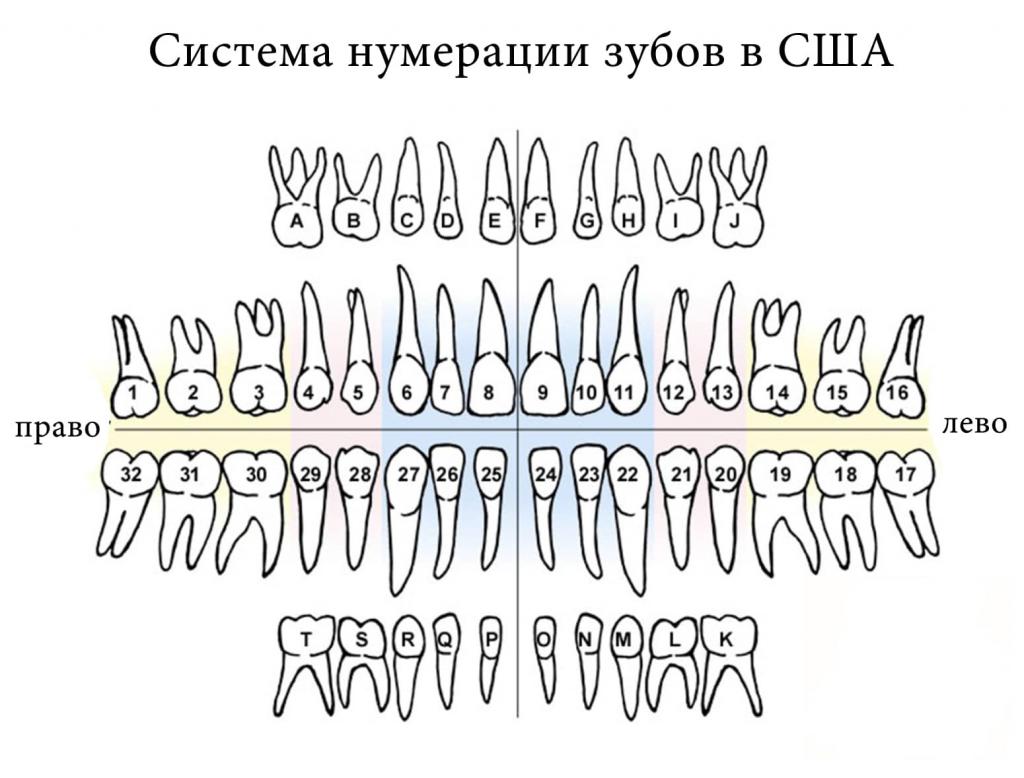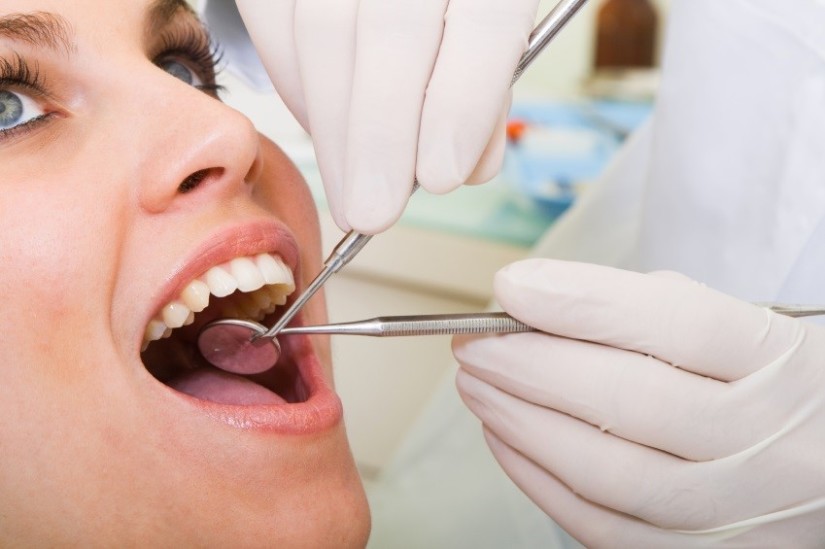In order for dentists from all over the world not to get confused in each other's notations, a common system of tooth counting has long been invented. It is also important when changing the attending physician, so that a new specialist can immediately understand which ones have already been treated and which ones the patient does not have at all (maybe such). How to correctly count teeth in dentistry, future specialists are taught at universities, and this article will help ordinary patients to understand.
Tooth prescription
The jaw of each person consists of certain segments with their own functions. They depend on the location of the tooth unit and its size. The front incisors are intended for biting off food, of which there are 2 pairs on each jaw.
They are located in the center and are visible even with the most modest smile. After them, fangs are located on the jaw. There are only 4 of them in the mouth, and they are designed to hold food and help in biting it off. Next are premolars, 2 on each side of the jaw, and molars, 3 on each side. They are intended for chewing and grinding food. The third molar is considered to be the wisdom tooth, and since they grow in many people already at a fairly advanced age, and in some recently they do not grow at all, only two molars will be indicated in the dental map.
The basic principle of numbering
The countdown always starts from the central incisors and goes both ways, regardless of how the dentists consider the teeth. Unit numbers are assigned according to their location in that order, and in some systems and in accordance with the functions. Each jaw thus has 2 rows of teeth directed to the left and right of the central incisors. Each row has 2 incisors, 1 canine, 2 premolar and 3 molars, their numbers are assigned accordingly.
How do dentists count teeth by numbers? Thus, the first central incisor of each row is number 1. The second incisor is 2, the canine is 3, the premolars are 4 and 5, respectively, and the molars are 6, 7 and 8. The last eighth is the wisdom tooth.
Row definition
According to the numbering described above, 4 rows of units have the same designation; it is possible to determine which of all fifth teeth requires treatment only with the additional specification of a specific segment. For this, the rows are also indicated in Arabic numerals strictly clockwise relative to the dentist. That is, for the patient, the first row will be the upper right segment, the second - the upper left, the 3rd - the lower left and the last fourth - the lower right.
How to count under such conditions? Each unit is indicated by the first number of the row number and the second by the number of the tooth itself. So, the central lower left incisor is the 31st, and all units of the lower right segment are indicated by the number 40. This is where almost all the ambiguities from the patients come from, because there are not so many teeth in the mouth.
This simple and intuitive chart will help you easily master the counting system described above.
In children
The scheme of milk teeth must necessarily be different from the adult one, because if the same person first treats milk teeth, and then permanent ones with the same location, difficulties will arise in filling out the dental card. To eliminate all the ambiguities, numbering is carried out according to the same principles, but the rows are assigned completely different designations.
How to count teeth in children? The right upper row is correctly denoted by the fifth ten. That is, the first cutter on it has the number 51, and so on. The upper left row is indicated by the number 6, the lower left - 7, and the lower right - 8. If the dentist calculates using such a system, then hearing that the child has caries of the 73rd, you do not need to imagine a mouth full of teeth.
In this case, it will be about the lower left canine. As soon as the children have permanent teeth, their numbering is no different from the adult scheme.
System convenience
The counting method described above is the most common and convenient, therefore, most often, dentists think exactly that. How and when the order of units was invented is not necessary for everyone to know, but it has been used in dentistry for almost 50 years and is called the two-digit Viola circuit. To indicate a tooth in it, no additional jaw card is required; the number can be calculated independently in the mind or transmitted in an oral conversation.
Of course, not all patients will now agree with the prevalence of the system, since some dentists use completely different designations, which are also generally accepted, studied by all specialists and can be used by them in their own practice.
Counting systems
To understand how dentists consider teeth in a particular clinic, it’s worth understanding all common systems. In addition to the two-digit, there are 4 more options:
- alphanumeric scheme;
- Haderup system;
- square digital system.
Each of them has separate designations for molars and primary teeth, but is convenient and simple in its own way, if you understand its principles.
Letter designation
This system was developed by the American Association of Dentists, therefore it is especially common in the United States. Of all the known variants, the alphanumeric designation is considered the most complex and confusing, but if desired, an ordinary person can freely understand it. The numbers of dental units themselves in the system are assigned taking into account not only their location, but also the value. In this case, the molars are indicated by the letter M and their serial number is from 1 to 3 (total molars in each row are 3). In this case, the premolars carry numbers with the letters P, fangs - C, and incisors - I. To determine the segment in which the desired tooth is located, in addition to the serial number, a number with a row designation is placed after the letter. Thus, according to the Viola system, the lower left canine will be designated as the 33rd, and according to the American system as C22.

How do doctors consider teeth for children in such a system? In this case, dairy is indicated by lowercase letters, and not capital letters, instead of a serial number, another letter designation from A to K can be used in a clockwise direction.
Haderup system
This principle of calculation is based on the designation of the units of the upper jaw with a “+”, and the lower jaw with a “-”. The numbering is standard, the upper incisors are designated as 1+. The lower third molars in this case will be numbered 8-. It is interesting, but the designation of the segment is not provided in this case, and in order to understand which side the desired tooth is located in, it is necessary to look in a special table.
To indicate the location of the milk tooth, 0 is added to its serial number, the upper incisor is already recorded as 01+.
Sigmondi-Palmer scheme
To understand how to count teeth by numbers, you also need to understand the oldest system for designating them. Most often, it is used by orthodontists, maxillofacial surgeons. But the principle is that the indigenous are described in Arabic numerals, and the dairy are described in Roman. Each dental unit of an adult is assigned a number from 1 to 8, and milk in children - from I to V. The location of the row does not have any additional designations, and it is possible to determine exactly where the tooth is located using a special jaw scheme.
The system is also called square-digital and, despite the complexity of the notation and inconvenience, is still used in some clinics.
Exceptions to the Rules
Infrequently, but nevertheless, certain abnormalities in development occur in people. So, you can meet a perfectly healthy person with six fingers on his hand or a non-standard number of dental units. How do dentists consider teeth in such cases? The use of standard schemes is impossible, and doctors have to completely abandon them. The number of teeth in this case simply corresponds to the card indicating their location and purpose.

That is, the document clearly indicates which particular dental units are more - incisors or molars, how many of them and on which segment they are located. In this case, anomalies of color, size, structure or shape do not affect the rejection of the standard scheme. Teeth indicate their location by assigned numbers. But their deviations from the norm are necessarily recorded in a medical document. If, under certain circumstances, the patient lost a tooth, then they do not refuse the designation scheme, but simply indicate the absence of a specific unit in the segment. The presence of a prosthesis is likewise indicated.
Conclusion
It is definitely impossible to answer the question of how dentists correctly consider teeth, since there are several types of generally accepted schemes that were described in the article. Each specialist has the right to use the system that is most convenient for him or which is taken as the main one in the clinic where he works, but the dentist must know the features of each scheme. This is necessary for the competent filling of medical documentation and determining by other specialists which particular teeth were treated.

Difficulties in self-determination of numbers in people do not arise so often, as doctors try to explain to their patients exactly where the problem is, in an accessible language. If this does not happen or there is a desire to simply understand all the tricks for yourself, from the article you can learn in detail all the features of each counting system. Knowledge in dental literacy will help to establish mutual understanding between the client and the dentist, since it will help to more accurately determine the place of the disturbing tooth. Also, the patient will understand what exactly the specialist is talking about, without further explanation. In fact, the arrangement of the dental units is simple, and everyone is able to understand them without outside help. The article describes in detail all the nuances of each of the schemes used in practice by dentists, so now you can easily familiarize yourself with all the terms and symbols of your medical document.